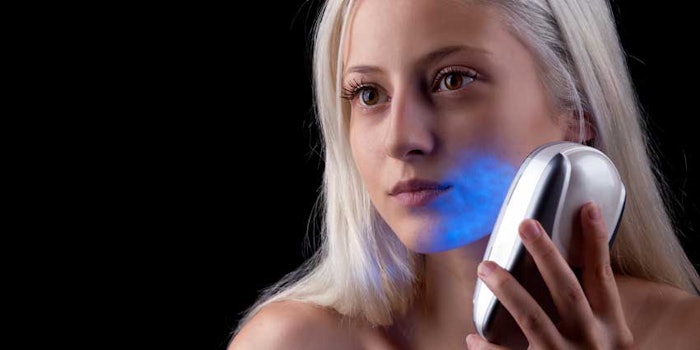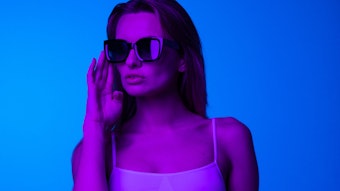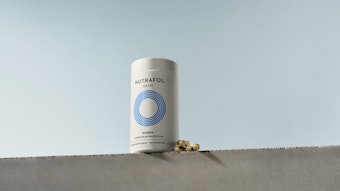
While many researchers are studying the damaging effects of blue light, there is also an opposing view. Blue light can be used as a therapeutic technology, based on how much light is emitted to benefit skin without inducing sub-clinical inflammation.
Treating Skin Conditions
Between device screens, neon signs and the sun, blue light always surrounds us. Falling in the 400-500 nm range, blue light is used as a low-level light therapy to safely treat acne vulgaris.
Ali Fassih, research manager and Michael Southall, research director fellow at Johnson & Johnson Consumer, Inc. (J&J), explained the significance of blue light therapy.
“Our research found that exposure of Propionibacterium acnes (P. acnes), which is a causative agent of acne, to 440 nm light results in bacterial cell death,” they said. “Our work demonstrates the antimicrobial activity of 440 nm blue light against P. acnes.”
Not only can blue light devices treat acne, but also psoriasis. Royal Philips—a health technology company in the Netherlands—launched the first wearable blue light emitting diode (LED) light therapy device to treat psoriasis vulgaris.
The company’s BlueControl wearable device gives off a UV-free blue LED light to help reduce mild psoriasis symptoms, according to clinical studies. Using this device stimulates natural, drug-free processes to reduce redness, scaling and thickness of psoriasis plaques.
Lasting Effects with LED Light
According to Fassih and Southall, blue LED light is proven to kill acne-causing bacteria.
“When exposed to blue LED light at the correct intensity, results have shown antibacterial activity,” said Fassih and Southall. “This activity kills P. acnes and helps to effectively treat acne vulgaris.”
The J&J researchers continued, “Once this bacteria is removed from the skin, the chances of further acne appearing decreases. The effectiveness of the blue light therapy is dependent on both time of exposure and light intensity.”
Dermatology Support
Skin professionals and dermatologists have used blue light therapy to improve skin for numerous years.
“Dermatologists have been using light therapy to treat acne at higher energy wavelengths between 405-420 nm targeting chromophores present in P. acnes,” said Fassih and Southall. “However, recent studies suggest that the visible light in these wavelengths may induce sub-clinical inflammation and activate photo-damage pathways. We have investigated this issue and proved that LEDs emitting 440 nm blue light deliver results of antibacterial activity without inducing sub-clinical inflammation.”
While acne is already looked at by dermatologists, psoriasis is next to be considered as Philips plans to begin engaging dermatologists and patient support groups in the United States following U.S. Food and Drug Administration clearance. BlueControl is preparing to launch in the United States in 2018.
“We are pleased that we can now start marketing this innovative home treatment solution for psoriasis to dermatologists in the United States so that they will be able to prescribe Philips BlueControl to their patients,” said David Aubert, general manager of Philips' Light & Health business.
BlueControl is currently marketed in selected countries such as Germany and the U.K. The device was designed to give patients freedom of movement. The device is rechargeable and battery-powered and has adjustable straps for comfort. It can be worn on affected areas including arms, legs, elbows and knees.
Blue Light Treatment at Home
While visiting a dermatologist’s office gives clients the ease of mind of working with a professional, they also have the option of using this technology at home.
“As a company, we aim to improve peoples’ health with a broad portfolio of proven therapy solutions to enable patients with chronic conditions to manage their health at home,” said Aubert. “Philips’ BlueControl is a clinically proven light therapy device that can be easily integrated into a patient's daily routine.”
While devices such as these are developed for use at home, the J&J researchers warn to always be mindful of safety when deciding whether to go into an office for treatment or to work with an at-home light therapy treatment.
“Considering the [positive results of our] study for the safety and effectiveness of 440 nm blue light therapy, consumers should research the wavelengths of blue light being used, whether at home or in office, before following through with any acne treatment,” said Fassih and Southall.
While blue light therapy use is on the rise, further research must be conducted on its effects on the skin, according to the J&J researchers.










